
Spitalfields is a district in the East End of London and within the London Borough of Tower Hamlets. The area is formed around Commercial Street and includes the locale around Brick Lane, Christ Church, Toynbee Hall and Commercial Tavern. It has several markets, including Spitalfields Market, the historic Old Spitalfields Market, Brick Lane Market and Petticoat Lane Market. It was a Hamlet of the large ancient parish of Stepney in Middlesex, and became an independent parish in 1729. Just outside the City of London, it formed part of the County of London from 1889 and was part of the Metropolitan Borough of Stepney from 1900. It was abolished as a civil parish in 1921.



Christ Church Spitalfields is an Anglican church built between 1714 and 1729 to a design by Nicholas Hawksmoor. On Commercial Street in the East End and in today's Central London it is in the London Borough of Tower Hamlets, on its western border facing the City of London, it was one of the first of the so-called "Commissioners' Churches" built for the Commission for Building Fifty New Churches, which had been established by an Act of Parliament in 1711.
A tenterground, tenter ground or teneter-field was an area used for drying newly manufactured cloth after fulling. The wet cloth was hooked onto frames called "tenters" and stretched taut using "tenter hooks", so that the cloth would dry flat and square.
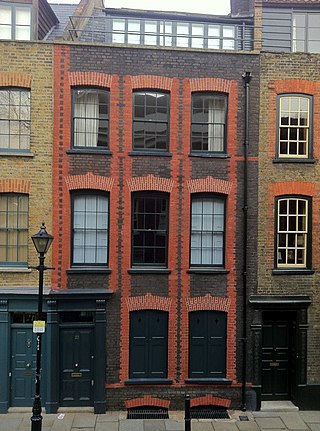
Fournier Street, formerly Church Street, is a street of 18th-century houses in Spitalfields in the East End of London. It is in the London Borough of Tower Hamlets and runs between Commercial Street and Brick Lane. The street is named after a man of Huguenot extraction, George Fournier.

Kirkgate Market is a market complex on Vicar Lane in the city centre of Leeds, West Yorkshire, England. It is the largest covered market in Europe and a Grade I listed building. There are currently 800 stalls which attract over 100,000 visitors a week.

Bunhill Row is a street located in St Luke's, London Borough of Islington, London. The street runs north–south from Old Street to Chiswell Street. On the east side are the cemetery of Bunhill Fields and the open space of the Honourable Artillery Company's Artillery Ground.
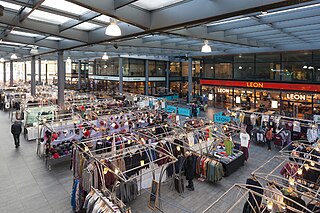
Spitalfields Market is a traders' market as well as a food and art market located in Spitalfields, Central London. Traders began operating around 1666, after the Great Fire of London, where the market stands today. The Spitalfields regeneration programme that ended in 2005, resulted in two new public spaces – Bishops Square and Crispin Place, which restored several historic streets and resulted in more independent retailers and restaurants. Spitalfields Market is situated in the London Borough of Tower Hamlets. It is surrounded by Lamb Street, Old Spitalfields market, Brushfield Street and Bishops Square.

Anna Maria Garthwaite was an English textile designer known for creating vivid floral designs for silk fabrics hand-woven in Spitalfields, London, in the mid-18th century. Garthwaite was acknowledged as one of the premiere English designers of her day. Many of her original designs in watercolours have survived, and silks based on these designs have been identified in portraiture and in costume collections in England and abroad.
The Sainsbury family founded Sainsbury's, the UK's second-largest supermarket chain. Today, the family has many interests, including business, politics, philanthropy, arts, and sciences.

Brick Lane Mosque or Brick Lane Jamme Masjid, formerly known as the London Jamme Masjid, is a Muslim place of worship in Central London and is in the East End of London.

Sandy's Row Synagogue is a historic Grade II listed synagogue and former Christian church in the East End of London. Built by refugee French Huguenots in 1766, it was later converted into a Baptist chapel and in 1867 was acquired by a Jewish congregation. It is the oldest surviving Ashkenazi synagogue in London.

Raven Row is a free art exhibition centre in Spitalfields. It was constructed from numbers 56 and 58, Artillery Lane. These properties were built about 1690. The area was formerly used for testing artillery and this portion of the lane was known as Raven Row until 1895. No. 56 and 58 had been rebuilt in the 1750s for use by Huguenot silk weavers and traders. The buildings were converted into a gallery in 2009 by 6a architects on behalf of Alex Sainsbury, who established a charity to run it. The inaugural exhibition was of work by New York artist Ray Johnson. Raven Row has held exhibitions by K.P. Brehmer, Iain Baxter, Adam Chodzko, Suzanne Treister, Peter Kennard, Hilary Lloyd, Harun Farocki, Eduardo Paolozzi, Stephen Willats and Yvonne Rainer. Other exhibitions have been curated by Richard Grayson, Lars Bang Larsen and Alice Motard.
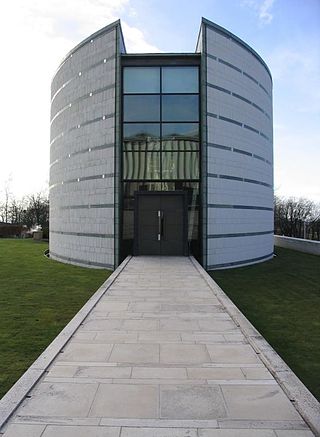
Sir Richard Cornelius MacCormac CBE, PPRIBA, FRSA, RA, was a modernist English architect and the founder of MJP Architects.
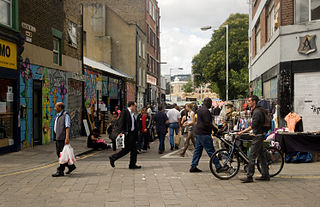
Brick Lane Market is the collective name for a number of London markets centred on Brick Lane, in Tower Hamlets in east London. The original market was located at the northern end of Brick Lane and in the heart of east London's Bangladeshi community but now commonly refers to the various markets that are housed along the famous London street. The various markets that stretch the length of Brick Lane operate both weekdays but most historically weekends: Saturday from 11 a.m. to 6 p.m. and Sunday from 10 a.m. to 6 p.m.
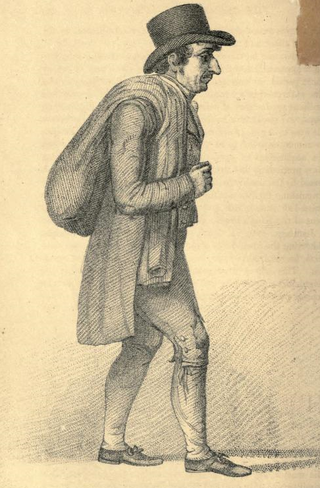
Henry Lemoine (1756–1812) was an English author and bookseller.

Trinity Green Almshouses are a series of Grade I listed almshouses on Mile End Road in Whitechapel in London. They were originally built in 1695 to provide housing for retired sailors, and are possibly the 2nd oldest almshouses in Central London, The Charterhouse, founded by Thomas Sutton in 1611 being the oldest.. The buildings were damaged during the Second World War, and were restored in the 1950s by London County Council.


















